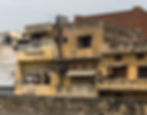What Should You Do in a Shaking Building?
- cedillos5
- Feb 14, 2015
- 3 min read
Updated: Sep 28, 2020
In the unnerving seconds when earthquake shaking begins, a person’s action may spell the difference between safety and suffering. But what to do? There is no simple answer.
GHI is studying how to develop the right advice, and how to deliver it in an effective message. Here is the difficulty: a protective action may work in one shaking situation but not in another.
Around the world, standard advice ranges from “drop, cover and hold on” to its opposite, “run out of the building.“ Some regions teach “go to a safe zone.” Instructions also persist in local folklore. For example: crouch, put thumbs on the floor, hug the middle pillar, or touch something brass in Nepal. Or take seven steps from danger in Afghanistan.

The most effective action to take during earthquake shaking may vary, depending on building type, nearby buildings, and external falling hazards. Shown here, dense urban construction in Delhi, India. Photo: GHI
Our goal is to move beyond conflicting messages and survivors’ anecdotes, to create an evidence-based approach for protective actions. We have drawn from available research, data from past earthquakes, and the judgment of experts in several fields.
The focus is low- and middle-income countries, where buildings are particularly vulnerable to damage from shaking. Our intended audience is people who develop protective action messages. They might work in a disaster management agency, a non-profit, or a scientific organization.
To start, we tapped 73 professionals involved in earthquake messaging, from 23 countries, to share experiences from their nations. With help from Texas A&M sociologist Michelle Meyer, we surveyed them about messages they give and why, and we surveyed 652 residents of India, Turkey and Peru about what messages they receive and action they would take. Actions perceived as most effective varied by country: “run out of the building” in India, “drop, cover, hold on” in Turkey, and“go to a safe zone” in Peru.
We asked 5 experts (in seismology, structural engineering, communication, of risk, behavior in earthquakes, and epidemiology of earthquake casualties) to prepare papers that would provide background facts and data. Messaging professionals met with these experts in a workshop, where they discussed likely rural and urban building scenarios and agreed on processes for developing protective actions messages.
Some key principles emerged. Most important, no single message can apply in every community. Buildings vary in their vulnerability to collapse and proximity to one another; levels of shaking vary with site conditions and nearness to faults; social and demographic factors dictate when people are inside buildings.
Message content should consider experts’ findings, such as: How much time will people have to evacuate before the strongest shaking? Are people safer outside or in? If outside is safer, can people evacuate in time? Do local beliefs impact choices?
USGS seismologist Susan Hough found that in major earthquakes, aside from rare “direct hits” or where studies make specific predictions, there will typically be a delay of at least 5 seconds between the initial P-wave shaking and the more damaging S-wave shaking. The finding led to a new message: “you may only have five seconds to act.”
People must understand the reasons for protective actions so that they can adapt. For example, running out of a rural, one-story masonry building escapes likely disaster, but running out of a tall building onto an urban street risks entering a “kill zone” of falling glass, walls, and façades.
The messaging strategy should include input from people in the community, because how the message is communicated determines if people receive it and act. Local beliefs and special needs should be addressed. Schools deserve special consideration, because dense occupancy, poor construction quality, and evacuation constraints leave students especially vulnerable.
Protective actions will not safeguard everyone in every earthquake. They should support a broad campaign to prepare. The best protection is to ensure safe construction before an earthquake, by enforcing a building code, strengthening vulnerable structures, or relocating.
Stay tuned for more details. United States Agency for International Development-Office of Foreign Disaster Assistance (USAID-OFDA) provided funding for the research papers and GHI’s “Guidance on Developing Messages for Protective Actions to Take During Earthquake Shaking,” to be completed in 2015.
